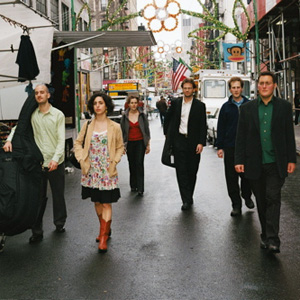
For piano and five other instruments; premiered by the Mills CPE Ensemble; performance above by the NOW Ensemble at Taplin Auditorium, Princeton University. 14 minutes, 29 seconds.
See score as PDF (right or control-click to download)
Six for Seven is an early piece of mine consisting of six musical cells in 7/4 time that grow in an obsessively asymmetric manner and then gradually dissipate. It is a true collaboration with the performers, in that each of them comes up with their own riffs in response to the piano cells that are given to them.
It was 1998 and I’d just started studying with Pauline Oliveros. I was a hesitant young composition student. I had tons of ideas; and I’d barely written a piece of music before. She struck me as a cross between a wise old fisherwoman and a Zen master. I was in love with Cage’s Sonatas and Interludes and told her so. For a month. I named orchestras I was going to start. I was full of plans.
Finally: “You need to stop talking about music and go make some!” along with directions to the nearest hardware store. “Bring a prepared piano piece next week.” You can just write a piece, like that, I thought? And so off I went to the hardware store, and had a grand time placing nuts and bolts into one of the old Mills pianos and improvising away. I was kind of obsessed with the sounds I got out of that old piano. I found a trust in the material. I was interested in repeating it, in getting to the nut of its secret, in listening to it from all kinds of angles.
And once I got into the structure of the piece I fell into a kind of numerological spell. I was obsessed with the symmetries, and of the return to the original, locomotive riff. I spent hours writing down these bizarre shapes filled with numbers trying to figure out the right structure. I know I was influenced in this by Cage’s early percussion pieces and the way that their macrocosmic and microcosmic structures fit together.
I loved the symmetry (still do!) of going back to that first, locomotive riff. It has to do with my love of process, of finishing a cycle. I also love the ways that the piece turns on a dime between six very different scenes. It’s cinematic in that way; a kind of journey. It’s a montage of differing emotional worlds. The instructions for the cells are: “ chugging along,” “hansel & gretal,” “spy movie,” “guileless,” “solemn and majestic,” and “sweet and scary.”
It’s also participatory; I wanted to bring the personalities of the players into the piece by allowing them to make up their own riffs. You can really hear the musical personalities of the NOW Ensemble in the performance above, and I love that.
Six for Seven has had (practically) nine lives. It began as an hour-long solo prepared piano piece; was premiered as a structured chamber improvisation; was premiered in the above performance in its semi-permanent state (with the score below); and was reinvigorated in 2010 when I did a solo multimedia performance of it at both Roulette and Brown University with an electric piano and four walls of video.